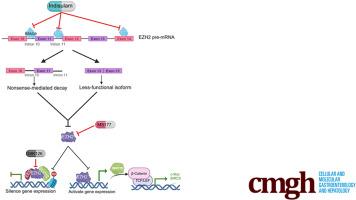RBM39通过EZH2介导的WNT7B/β-catenin通路促进胆管癌生长
IF 7.1
1区 医学
Q1 GASTROENTEROLOGY & HEPATOLOGY
Cellular and Molecular Gastroenterology and Hepatology
Pub Date : 2024-09-14
DOI:10.1016/j.jcmgh.2024.101404
引用次数: 0
摘要
背景和目的:RNA 结合基序蛋白 39 (RBM39) 在多种癌症类型中既是 RNA 结合蛋白,又是剪接因子。然而,RBM39在胆管癌(CCA)中的功能仍未确定。本研究旨在研究 RBM39 在 CCA 中的作用,并探索其作为治疗靶点的潜力:方法:通过分析人类 CCA 肿瘤标本研究 RBM39 在 CCA 中的表达。方法:通过分析人CCA肿瘤标本,研究了RBM39在CCA中的表达,并在体外和体内进行了CRISPR/Cas9或shRNA介导的RBM39去除,以证实RBM39在CCA中的致癌作用。在体外和体内评估了RBM39抑制剂Indisulam与EZH2降解剂MS177联合使用的抗肿瘤效果:结果:RBM39在人类CCA组织中明显增加,并与CCA患者的不良预后有关。通过CRISPR/Cas9或shRNA去除RBM39可抑制体外CCA细胞的增殖,并阻止小鼠CCA的发生和肿瘤的生长。从机理上讲,我们的研究结果表明,RBM39的缺失是通过破坏其mRNA剪接来抑制EZH2的表达。RBM39调控的EZH2控制着WNT7B/β-catenin的活性。通过药理作用共同靶向 RBM39(使用 Indisulam)和 EZH2(使用 MS177),可在体外和体内产生协同抗肿瘤效果:本研究揭示了对 CCA 生长至关重要的新型 RBM39-EZH2-β-catenin 信号轴。我们的研究结果表明,同时抑制 RBM39 和 EZH2 是一种治疗 CCA 的有效策略。本文章由计算机程序翻译,如有差异,请以英文原文为准。

RBM39 Enhances Cholangiocarcinoma Growth Through EZH2-mediated WNT7B/β-catenin Pathway
Background & Aims
The RNA-binding motif protein 39 (RBM39) functions as both an RNA-binding protein and a splicing factor in a variety of cancer types. However, the function of RBM39 in cholangiocarcinoma (CCA) remains undefined. In this study, we aimed to investigate the role of RBM39 in CCA and explore its potential as a therapeutic target.
Methods
The expression of RBM39 in CCA was investigated by analyzing human CCA tumor specimens. CRISPR/Cas9 or shRNA-mediated depletion of RBM39 was performed in vitro and in vivo to document the oncogenic role of RBM39 in CCA. The anti-tumor effect of the RBM39 inhibitor, Indisulam, in combination with the EZH2 degrader MS177 was assessed in vitro and in vivo.
Results
RBM39 is significantly increased in human CCA tissues and associated with a poor prognosis in patients with CCA. Depletion of RBM39 by CRISPR/Cas9 or shRNA inhibited CCA cell proliferation in vitro and prevented CCA development and tumor growth in mice. Mechanistically, our results showed that depletion of RBM39 suppressed EZH2 expression via disrupting its mRNA splicing. RBM39-regulated EZH2 controls WNT7B/β-catenin activity. Pharmacological co-targeting of RBM39 (with Indisulam) and EZH2 (with MS177) resulted in a synergistic antitumor effect, both in vitro and in vivo.
Conclusion
This study discloses a novel RBM39-EZH2-β-catenin signaling axis that is crucial for CCA growth. Our findings suggest that simultaneous inhibition of RBM39 and EZH2 presents a promising therapeutic strategy for CCA treatment.
求助全文
通过发布文献求助,成功后即可免费获取论文全文。
去求助
来源期刊

Cellular and Molecular Gastroenterology and Hepatology
Medicine-Gastroenterology
CiteScore
13.00
自引率
2.80%
发文量
246
审稿时长
42 days
期刊介绍:
"Cell and Molecular Gastroenterology and Hepatology (CMGH)" is a journal dedicated to advancing the understanding of digestive biology through impactful research that spans the spectrum of normal gastrointestinal, hepatic, and pancreatic functions, as well as their pathologies. The journal's mission is to publish high-quality, hypothesis-driven studies that offer mechanistic novelty and are methodologically robust, covering a wide range of themes in gastroenterology, hepatology, and pancreatology.
CMGH reports on the latest scientific advances in cell biology, immunology, physiology, microbiology, genetics, and neurobiology related to gastrointestinal, hepatobiliary, and pancreatic health and disease. The research published in CMGH is designed to address significant questions in the field, utilizing a variety of experimental approaches, including in vitro models, patient-derived tissues or cells, and animal models. This multifaceted approach enables the journal to contribute to both fundamental discoveries and their translation into clinical applications, ultimately aiming to improve patient care and treatment outcomes in digestive health.
 求助内容:
求助内容: 应助结果提醒方式:
应助结果提醒方式:


